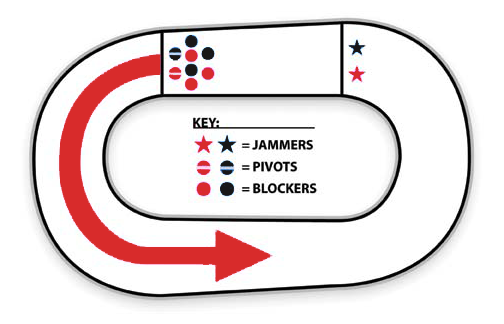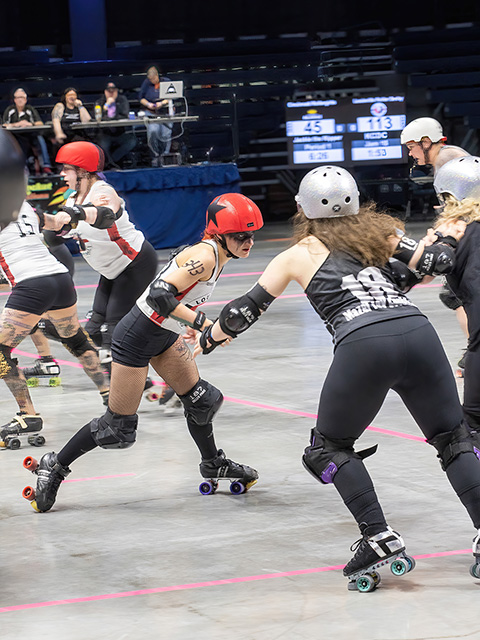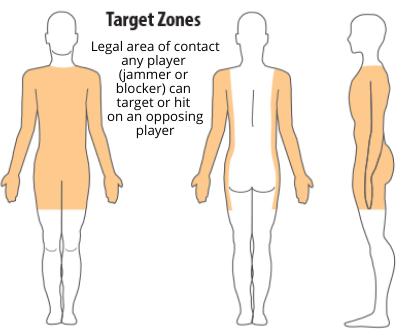What even is roller derby?
The Basics
Flat track roller derby is a full contact sport played on quad roller skates on a flat, oval track. Gameplay moves in a counter-clockwise direction (also known as derby direction). Each game consists of two 30 minute halves that are further divided into as many 2 minute (or less) jams as possible. The winner of the game is determined by the team who has scored the most points. Each team will field 4 blockers and 1 Jammer per jam. Offense and defense are played simultaneously.
The pack is the largest group of in-bounds blockers from both teams. All legal gameplay must be kept within the pack’s engagement zone in order to be considered legal. This zone starts 20 feet in front of the pack and ends 20 feet behind the pack.

Positions in Roller Derby
Pivots
Pivots (striped helmet cover) are a special type of blocker that can take over the position of Jammer during gameplay. Once per jam, Jammers are allowed to pass their star helmet cover to their Pivot. Once the Pivot puts on the jammer's star, they are now able to earn points for their team. The original Jammer then becomes a regular blocker. Each team can only have one Pivot on the track per jam.
Blockers
Blockers have two main jobs. Defense, which means blocking the opposing team's Jammer, and offense, which is helping their own Jammer score more points.
Jammers
Jammers (star helmet cover) try to score points by passing the hips of the opposing team's blockers (1 Blocker = 1 point). Jammers also control the length of each jam by being the first to exit the pack and earning "Lead Jammer" status. Lead Jammers can end any jam early by tapping their hips with their hands.
Roller Derby in Action
Jam Start
All players have 30 seconds between each jam to get in position and await the jam start whistle. Jammers line up on the track behind the Blockers.
First Pass
Once the jam start whistle is blown, both Jammers enter the pack from behind for their initial pass. The first jammer to legally pass all skaters is awarded “Lead Jammer” status.
Second Pass
The rest of the jam is all about earning points. To earn a point, a Jammer must pass her hips in front of the hips of an opposing blocker. Each opposing blocker is considered 1 point, so Jammers can earn up to 4 points per pass.
Ending a Jam
The jam ends once two minutes are up or when the Lead Jammer signals the end of the jam by touching their hips twice.

Legal Gameplay
- Contact with the hips, thighs, butts, upper arms, shoulders, and sides.
- Skating “derby direction” (counter clockwise) when making contact with another player.


Illegal Gameplay
- Gaining position through use of: Forearms or elbows, cutting the track, tripping or low blocking another player.
- Blocking or hitting: With the head or to another player’s head, to another player’s back/spine, outside of the engagement zone, after the jam-ending whistle.
- Multiplayer: Creating an unbreakable link of hands/arms that impedes a jammer’s movement through the pack.
- Initiating contact while skating in non-derby direction (clockwise) that impacts an opposing player’s position on the track.
- Destroying the pack or failing to return to the pack when warned by a skating official.
- Skating out of bounds to avoid a block or hit from another player.
- Insubordination or rude conduct towards an official.
- Illegal passing of the helmet cover.
Penalties
If a player is issued a penalty by an official, that player must exit the track and report to the penalty box. Most penalties are 30 seconds in length, but it is possible for players to earn multiple penalties at once (ex. Insubordination penalty). A Jammer may be released from the penalty box early if the other team’s Jammer is also sent to the penalty box. If a player is issued 7 or more penalties, they are ejected from the game and cannot continue playing.
